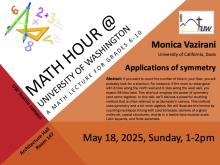Abstract:
If you want to count the number of tiles in your floor, you probably will not count each one individually, but be lazy and look for a shortcut. For instance, if the room is rectangular and walking part of its perimeter you discover there are 8 tiles along the north wall and 6 tiles along the west wall, you expect 48 tiles total. This shortcut employs the power of symmetry. (And a bit of algebra.)
In this talk, we’ll discuss a powerful counting method that is often referred to as Burnside’s Lemma, although it goes back to Frobenius (1887) and Cauchy (1845). This method uses symmetry and a bit more algebra. We will illustrate the lemma by counting necklaces strung with colored beads. Other applications include counting isomers of a given molecule, crystal structures, chords in a twelve-tone musical scale, Latin squares, and finite automata.
